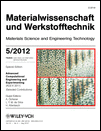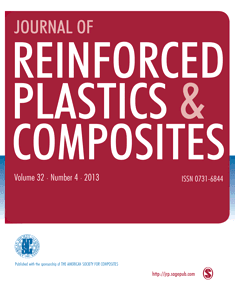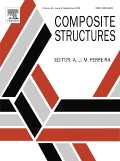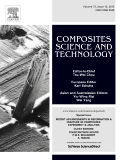
Composites Research
Scope & Guideline
Exploring the Frontiers of Composite Technology
Introduction
Aims and Scopes
- Composite Material Development:
Research on the synthesis, processing, and characterization of various composite materials, including polymers, ceramics, and metals, focusing on enhancing their mechanical, thermal, and electrical properties. - Advanced Manufacturing Techniques:
Exploration of innovative fabrication methods for composite materials, such as 3D printing, additive manufacturing, and advanced molding techniques to improve efficiency and material performance. - Performance Evaluation and Testing:
Systematic assessment of the mechanical, thermal, and chemical performance of composite materials under various conditions, including fatigue, impact, and environmental exposure. - Interfacial and Structural Analysis:
Investigation of the interfacial properties and structural integrity of composites, including studies on adhesion, fiber-matrix interactions, and failure mechanisms. - Applications of Composites:
Applications in diverse fields such as aerospace, automotive, electronics, and construction, focusing on the practical implications and advancements enabled by composite materials. - Sustainability and Eco-friendly Composites:
Research on the development of biodegradable or eco-friendly composite materials aimed at reducing environmental impact and promoting sustainability in material science.
Trending and Emerging
- Smart and Responsive Composites:
Research on composites that exhibit smart functionalities, such as shape memory effects and self-healing properties, is gaining traction, reflecting a growing interest in materials that can adapt to their environment. - Nanocomposites and Advanced Fillers:
The incorporation of nanomaterials and advanced fillers into composite formulations to enhance mechanical, thermal, and electrical properties is increasingly emphasized, showcasing the trend towards high-performance materials. - Sustainable and Biodegradable Composites:
A rising focus on the development of eco-friendly composites made from renewable resources and biodegradable materials reflects the industry's shift towards sustainability and environmental responsibility. - Data-Driven and Computational Approaches:
The application of machine learning, artificial intelligence, and data-driven methodologies in the design and analysis of composites is emerging as a significant trend, enabling more efficient research and development processes. - Multifunctional Composites:
Research on composites that combine multiple functions, such as structural integrity and energy harvesting, is on the rise, indicating an interdisciplinary approach to material science.
Declining or Waning
- Traditional Fiber Reinforcement Techniques:
Research on conventional fiber reinforcement methods, such as basic glass and carbon fiber applications, seems to be declining as newer materials and techniques gain attention. - Low-Performance Composites:
Studies focusing on low-performance or less specialized composite formulations are becoming less frequent, possibly due to a shift towards high-performance and multifunctional materials. - Basic Mechanical Testing:
Basic mechanical testing methodologies without advanced computational or innovative approaches are being overshadowed by more complex analyses involving simulations and predictive modeling. - Single-Material Focus:
Research centered solely on single-material composites, rather than hybrid or multifunctional composites, appears to be waning as the field moves towards integrating multiple materials for enhanced properties. - Traditional Applications in Non-Critical Sectors:
Applications of composites in less critical sectors, which do not emphasize advanced performance or sustainability, are being phased out in favor of research that targets high-impact industries.
Similar Journals

MATERIALWISSENSCHAFT UND WERKSTOFFTECHNIK
Innovating Tomorrow's Materials Today.MATERIALWISSENSCHAFT UND WERKSTOFFTECHNIK, published by WILEY-V C H VERLAG GMBH, is a prominent journal dedicated to the field of materials science and engineering. With its ISSN 0933-5137 and E-ISSN 1521-4052, this journal serves as a vital resource for researchers and professionals engaged in exploring the intricate relationships between the properties of materials and their applications. Established in 1970 and continuing through 2024, the journal has been consistently recognized in various categories, achieving a Q3 ranking in 2023 across Condensed Matter Physics, Materials Science (miscellaneous), Mechanical Engineering, and Mechanics of Materials. Although it does not offer open access, its high-quality peer-reviewed content is fundamental to the advancement of knowledge within its three key areas: novel material development, material characterization, and application of materials in engineering contexts. As a driving force in the scientific community, MATERIALWISSENSCHAFT UND WERKSTOFFTECHNIK continues to cater to the curiosity of aspiring students, seasoned professionals, and researchers alike, facilitating a deeper understanding of the complexities of material technology.

MATERIALE PLASTICE
Bridging Disciplines through Materials ScienceMATERIALE PLASTICE is a distinguished academic journal published by REVISTA CHIMIE SRL in Romania, focusing on the fields of Chemistry, Materials Science, and Engineering. With an ISSN of 0025-5289 and an E-ISSN of 2668-8220, this journal has a historical commitment to advancing the study of polymers and plastics since its inception in the early 1970s. Although classified in the Q4 category across multiple disciplines including miscellaneous chemistry and materials chemistry as of 2023, it serves as an important forum for researchers and professionals dedicated to innovative materials research and development. The journal’s resources, though not openly accessible, are pivotal for scholars seeking to deepen their knowledge in the mechanics of materials and interdisciplinary applications. MATERIALE PLASTICE is not only a repository of significant research findings but also a platform for fostering collaboration and discussion among a global audience that continues to strive for scientific excellence in polymer and materials studies.

Composites Part C: Open Access
Fostering Innovation in Composite ResearchComposites Part C: Open Access, an esteemed journal published by Elsevier, is at the forefront of research in the fields of Ceramics and Composites, Mechanical Engineering, and Mechanics of Materials. Launched in 2020, this fully open-access journal facilitates unparalleled access to significant advancements in composite materials, ensuring that research findings are disseminated widely and freely throughout the global academic community. With an impressive Q1 ranking across multiple related categories and robust placements in Scopus rankings, specifically #78 in Mechanical Engineering and #24 in Materials Science, the journal serves as a vital platform for researchers, professionals, and students to publish their work and engage with cutting-edge studies. It aims to foster innovation and collaboration in the development and application of composite materials and their technologies, making it an indispensable resource for anyone invested in these dynamic fields.

JOURNAL OF REINFORCED PLASTICS AND COMPOSITES
Unveiling Breakthroughs in Composite MaterialsWelcome to the JOURNAL OF REINFORCED PLASTICS AND COMPOSITES, a leading publication in the realms of materials science, engineering, and polymers. Published by SAGE Publications Ltd, this journal stands out with its robust Q2 ranking in multiple categories, including Ceramics and Composites, Materials Chemistry, Mechanical Engineering, and Mechanics of Materials. Since its inception in 1982, the journal has become an essential resource for researchers and professionals, disseminating pioneering research and innovative applications in reinforced plastics and composite materials. Though not open access, subscribers gain exclusive insights into groundbreaking findings contributing to the advancement of the industry. The journal is indexed in Scopus, with notable rankings that reflect its influence and high-quality scholarship. With ongoing coverage until 2024, the JOURNAL OF REINFORCED PLASTICS AND COMPOSITES remains committed to fostering academic dialogues and facilitating advancements in sustainable materials and advanced engineering solutions.

INTERNATIONAL JOURNAL OF CAST METALS RESEARCH
Bridging Theory and Practice in Cast Metals EngineeringInternational Journal of Cast Metals Research, published by Taylor & Francis Ltd, serves as a premier platform for the dissemination of cutting-edge research in the fields of Mechanical Engineering, Mechanics of Materials, and Metals and Alloys. With a commitment to advancing the understanding of cast metals, this peer-reviewed journal has achieved notable recognition, featuring a 2023 Q2 ranking in its respective categories and ranking 71st in the Materials Science field according to Scopus. Researchers and professionals will find a wealth of valuable insights through rigorous studies and innovative findings, reflecting the journal's goal of facilitating knowledge transfer and addressing contemporary challenges in material science. Furthermore, its accessible publication years from 1996 to 2024 ensure that it not only captures the evolution of technology in cast metals but also stands at the forefront of future developments. Ideal for academics and practitioners alike, the journal aims to foster collaboration and inspire new developments within the discipline.

COMPOSITE STRUCTURES
Pioneering Knowledge in Civil and Structural EngineeringComposite Structures, published by Elsevier Science Ltd, is a premier academic journal that has been at the forefront of research in the fields of Ceramics and Composites and Civil and Structural Engineering since its inception in 1983. With a remarkable Q1 ranking in both categories for 2023, it is recognized as one of the leading publications, occupying the 22nd position in Civil and Structural Engineering and the 14th in Materials Science, showcasing its high-impact contributions to the respective fields. The journal serves as a crucial platform for disseminating cutting-edge research, innovative methodologies, and comprehensive reviews that cater to the academic and professional community. Although it does not offer open access options, its robust impact factor and extensive reach through Scopus ensure that the articles published are widely cited and serve as valuable resources for enhancing the understanding of composite materials and structures. The journal invites contributions that push the boundaries of knowledge, making it an essential read for researchers, engineers, and students invested in advanced materials and structural applications.

COMPOSITES SCIENCE AND TECHNOLOGY
Driving Innovation in Composite Science and EngineeringComposites Science and Technology, a premier journal published by Elsevier Sci Ltd, serves as a vital resource in the fields of composite materials and engineering. With an impressive 2023 impact factor reflecting its influential contributions, this journal has established itself within the top tier of academic publishing, flaunting a Q1 ranking in both the Ceramics and Composites and Engineering (Miscellaneous) categories. Covering a diverse range of topics from the development of novel composite materials to their practical applications across various industries, it is recognized for its rigorous peer-review process and high-quality research outputs. As reflected in its Scopus rankings, Composites Science and Technology places in the 97th percentile among general engineering journals and the 94th percentile amongst ceramics and composites science literature. Researchers and professionals alike benefit from its comprehensive access to cutting-edge discoveries and advancements, making it an indispensable tool for driving innovation within this dynamic field.

POLYMERS & POLYMER COMPOSITES
Advancing Knowledge in Polymers and CompositesPOLYMERS & POLYMER COMPOSITES, published by SAGE Publications Ltd, is a prestigious journal dedicated to the exploration of significant advancements in the diverse fields of polymers, composite materials, and their innovative applications. With an ISSN of 0967-3911 and E-ISSN of 1478-2391, this journal plays a crucial role in the academic community, boasting an impressive ranking in the Q2 quartile across pivotal categories such as Ceramics and Composites, Materials Chemistry, and Polymers and Plastics in 2023. Positioned in the United Kingdom, it serves as a vital resource for researchers and professionals, providing insights into current trends and future directions in material science. Despite its availability not extending to Open Access, the journal aims to promote rigorous peer-reviewed research, thus fostering knowledge and collaboration among scholars. With publication convergence from 1993 to 2024, POLYMERS & POLYMER COMPOSITES stands as a cornerstone for those pursuing advanced understanding and excellence in material innovation.

Materials Testing
Pioneering Innovations in Material PerformanceMaterials Testing is a renowned journal published by Walter de Gruyter GmbH, serving the global scientific community in the fields of Materials Science, Mechanical Engineering, and Mechanics of Materials. With an ISSN of 0025-5300 and an E-ISSN of 2195-8572, this journal has been a significant contributor to the discourse on material performance, testing methodologies, and engineering innovations since its inception. The journal is recognized for its rigorous peer-review process and holds a commendable Q2 quartile ranking in multiple categories for 2023, showcasing its impact and relevance in the field. With open access options available, Materials Testing aims to disseminate valuable research findings and practical insights that drive advancements in technology and materials applications. By addressing the latest challenges and developments within the field, this publication serves as an essential resource for researchers, professionals, and students alike, fostering a deeper understanding of material properties and testing techniques.

Journal of Composites Science
Advancing the Frontiers of Composite MaterialsThe Journal of Composites Science, published by MDPI, is a premier Open Access journal dedicated to advancing the field of composites and materials science. Launched in 2017, this innovative journal provides a platform for researchers, professionals, and students to share findings, methodologies, and insights related to composites, ceramics, and engineering applications. With an impressive Q2 ranking in both the Ceramics and Composites and Engineering (miscellaneous) categories for 2023, the journal is well-positioned within the academic community, ranking 48th out of 204 in miscellaneous engineering and 47th out of 127 in ceramics and composites according to Scopus. The journal's open-access model ensures that high-quality research is widely available to the scientific community, fostering collaboration and innovation. Situated in defensive Switzerland at ST ALBAN-ANLAGE 66, CH-4052 BASEL, the Journal of Composites Science is an essential resource for those seeking to stay at the forefront of the composites domain and drive progress in engineering practices.